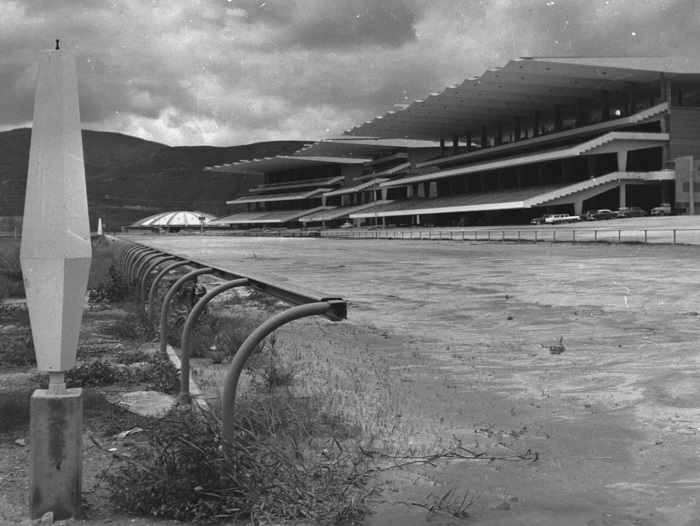
This is one of several history only, non commercial pages relating to the history of the automatic totalizator, its invention in 1913, the inventor George Julius and the Australian company he founded in 1917 which became a global monopoly ( later part of an oligopoly ) in this field. This page contains a document describing Caracas in the 1950s and the Julius totalisator installed there. It also contains recollections of multiple ex Automatic Totalisators Limited employees relating to the Caracas system.
| Julius tote installation in Caracas |
|---|
Caracas, installed in the 1950s, was amongst the latter-day Julius (electromechanical) totalisators. Automatic Totalisators' research department was laying the foundations for the development of a computer-based totalisator in the early 1950s. This research led to the development of the world's first computer-based totalisator , which was built for the New York Racing Association. The advent of the computer-based totalisator eventually led to the cessation of Julius tote production.
Postscript -
It is now June 2005 and I have just received mail from Caracas. I was informed that the Julius tote there is still in operation. After 48 years of operation I have been asked if I have any information on how to make adjustments to the system to bring it up-to-date! I have since read on the Internet that the Julius Tote was replaced in 2007. Half a century is a good lifespan for a computing machine!Neville Mitchell, a long serving manager at Automatic Totalisators, told me that when he started with Automatic Totalisators, the Caracas installation was regarded as the "flagship" of the Julius totes. In August 2015 Neville wrote the following about the Caracas system:
Over much time Caracas was held up as the epitome of Julius Totalisators and overtime some 50 operating years proved something.Regressing a moment, in March 2002, I was talking to Neville. For years I was under the impression that the Longchamps installation with its 273 terminals, was the largest of the operational electromechanical systems. Neville told me that Caracas which was installed 30 years after Longchamps was bigger! This piqued my interest in the Caracas installation. As you will read in this section Caracas was slightly short of Longchamps in number of ticket issuing machines, however the increased functionality of these machines meant there were effectively many more.
Us upstarts that were pulling ATL into the Computer age were attacked on many grounds citing Caracas as "King"
I have recently read a post world war 2 booklet titled The Julius Premier Totemobile, which lists all installations by number of terminals. It shows White City Stadium London as having 320 terminals.
In the same month I also communicated with Keith Dodwell, a long serving manager at Autotote. He wrote that Caracas had the latest large electromechanical adder that provided the ability to display pool totals. He also indicated that the Rio de Janeiro installation in 1950 was more unique and that it had 4 shaft adders per runner and each TIM could sell three pools and four different values. He also indicated that he was in his 59th year working for Automatic Totalisators/Autotote! Keith was very hospitable to me when I visited Autotote in 1983 after attending a DEC course in Boston on VAX 11/750 processor internals.
Since the previous paragraph was written, Keith Dodwell has retired. He served 60 years with Automatic Totalisators/Autotote, starting at 14 and finishing at 74. This must be some kind of record! Most people do not work for this long, let alone for the same organisation! Congratulations Keith!
In December 2003 I received a copy of a document from Matthew Connell at the Powerhouse Museum titled "Julius Premier Totalisators" by Totalisators Limited England. It records the Jockey Club Brasiliero, Rio de Janeiro, Brasil as having a Julius tote installation with win place and double pools, 45 runners or combinations, 5 indicators and 250 ticket issuing machines.
The following article has content that does not relate to totalisators. I have decided to include all of it here to satisfy my sense of completeness, as well as to provide content for the non technical reader and an interesting snapshot of 1950s Caracas.
Note - The background for this page comes from a picture in the original article. The only other image from the article is titled Artist's impression of the Caracas Control Room. I have included images from other sources to supplement the article.
| Fabulous Caracas |
|---|
Poised on the very crown of South America is the city of Caracas - a huge spectacular symbol of the soaring prosperity that oil has brought to Venezuela.
Although the city is 400 years old, Caracas can rightly claim to be one of the most modern and flourishing cities, not only in South America, but anywhere in the world.
Few cities in the world can boast of such an impressive highway as Caracas' "Autopista"; few cities can offer visitors a five-mile car ride over a 7,000-foot mountain to the sea; few cities have such modern and opulent hotels, apartment blocks, office buildings and avenues, and few cities will have such an elaborate and luxurious racecourse as the new Hipodromo Nacional.

Ten years or so ago Caracas was not the thriving city of a million progressive people that it is to-day. Now it is probably the fastest growing city in the world - faster even than the fabled city of Houston, Texas.
Travellers returning from South America all rave about Caracas. To them it is the city of South America, and Venezuela is the country they tell you to watch in the future. It is not oil alone that has made the difference, but the policy of "sowing the profits of oil" - in one of the world's largest and most epoch-making public works programmes. In 1956, for instance, this dynamic public works programme cost Venezuela something like £A250 million. But thanks to oil, Venezuela can afford it.
For the gigantic oilfields under Lake Maracaibo and elsewhere make Venezuela one of the great oil-producing areas of the world. And her enormous untapped reserves are considered vital for the defence of the free world in the event of war.
The results of this oil boom, and the public works programme that it has made possible, can be seen all over Caracas.
Its public thoroughfares are no longer rough and narrow roads, but wide and streamlined avenues. The "ranchitos" on the mountainsides are giving way to huge, vividly-coloured apartment blocks. A coffee plantation has been replaced by the great new University City.
But there are many other things in Caracas of which the Venezuelan people are proud. Three in particular - The Simon Bolivar Centre, the "Autopista" and the "Teleferico".
The Simon Bolivar Centre is regarded as the architectural achievement of South America. To New Yorkers, it is the "Rockefeller Centre" of Latin America. Its twin skyscrapers are each 30 storeys high and house many of the government offices. Beneath the skyscrapers are shops, a terminal for 500 buses, and parking space for 1,600 cars.
The great engineering achievement of Caracas is the "Autopista" - the super-highway that sweeps through the Andean foothills from the Caribbean port of La Guaira to Caracas, 11 miles inland and 3,000 feet up in the mountains.
The most remarkable thing about this highway is that it is eight miles shorter than the old road and has only 36 curves. The old road had no less than 365 bends. This has meant that driving time from Caracas to the sea has been cut from one hour to only 15 minutes. This six-lane highway, opened in 1953, took three years to build and cost about £A25 million.
But the "Autopista" does not provide the only route to the coast. There is an even more exciting means of transport - by aerial cable car, or "Teleferico", over the mountains. This five-mile aerial cable line is the longest in the western hemisphere. It swings up from the city to the top of Mt. Avila (7,000 feet) and then down the other side to the ocean.
The trip takes only 15 minutes, and is certainly one of the most thrilling aerial car rides in the world. Passengers can, if they want to, ride only as far as Mt. Avila and stop off there on the top at the Humboldt Hotel.
The Humboldt, with its circular design, gleaming glass and aluminium exterior, is one of Caracas' outstanding landmarks, standing as it does on the mountain overlooking the city.
The 14-storey Humboldt has its own branch aerial car line connecting with the main line over the mountain. On the branch line, passengers travel in small, round, six passenger cars nicknamed "Cinderella Pumpkins". From the hotel, the visitor gets a splendid panoramic view of the expanding, colourful city of Caracas stretched out beneath in the valley.
Already another equally spectacular landmark is being planned for Caracas - a huge, cone-shaped shopping centre. This massive building will look something like a gigantic beehive, and will house some 240 shops served by a spiral roadway winding round the outside in several complete circles to the top. This building, to be called the "Helicoid", will also contain offices, garages, television studios, an auditorium, hotel, dance-hall, restaurants and its own heliport. The "Helicoid" is expected to cost £A11 million to build.
Webmaster's Comment: I think the background of this page is an artist's impression of the Helicoid
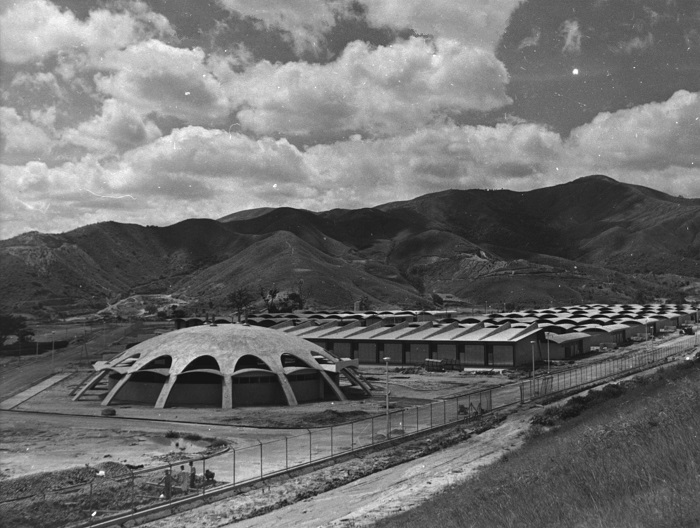 Hippodromo Nacional stables area.
Hippodromo Nacional stables area.
Webmaster's Comment: The flare for architecture in the Helicoid can also be seen at the racetrack in the images above and below
But long before the "shopping centre of the future" becomes a reality, the residents of Caracas will enjoy the facilities of a new race track, the Hippodromo Nacional, certainly the most modern and one of the most luxurious in the world.
Credit for the design of this race track goes to Mr. Arthur Froelich, A.I.A., of Los Angelis, noted throughout the Americas as a leading race track architect, designer and consultant.
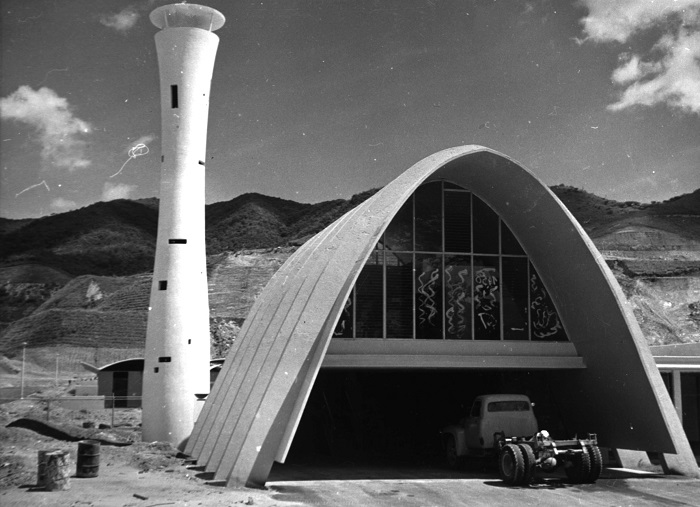
Webmaster's Comment: The architectural flare extends to the works area of the track! Does the Garage look like a good shape to base an opera house on? I worked in the Sydney Opera House on the installation of the electro-acoustic audio and the closed circuit television systems long after this track was built. The tower looks like it might be a judges or stewards tower.
One of the highlights of the Hippodromo Nacional is the totalisator equipment, which embodies "push-button control" and the most elaborate security measures of any totalisator installation anywhere in the world.
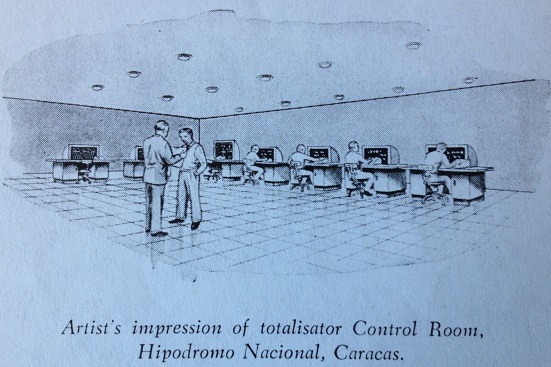 Artist's impression of the Caracas Control Room
Artist's impression of the Caracas Control Room
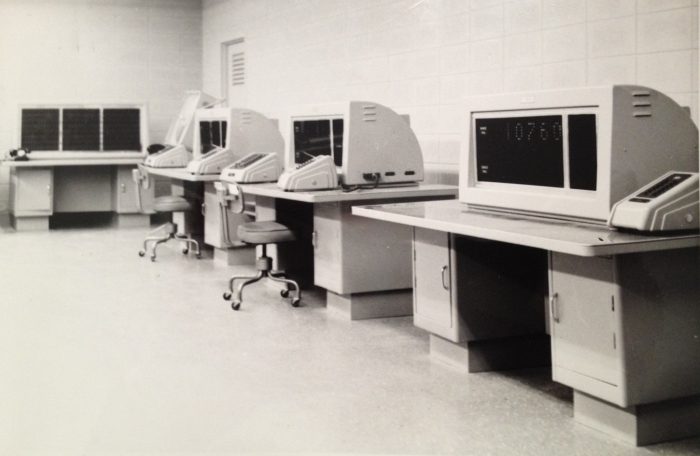 Image of the Caracas Tote Control Room
Image of the Caracas Tote Control Room
The control room which is the pulse of the totalisator, provides for "push-button" instantaneous monitoring of information on the betting position on any horse, or the odds on any horse on any one of eleven indicator boards on the track. As far as is known, the new Caracas race track will have more indicating boards than any other race track in the world and will also have the largest in-field indicator. In this respect, at least one indicator is visible from any selling position on the track, so that the investor is never without the latest betting information.
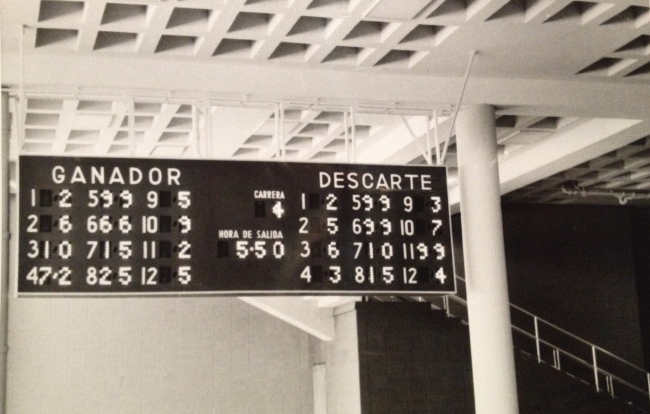
In the previous paragraph, the author mentions the Caracas Julius Tote infield indicator being the largest in the world. I have presented an image of this indicator below. It reminds me of the ATL infield indicator at Eagle Farm racecourse in Brisbane that my staff and I maintained for approximately 3 decades. The Eagle Farm infield indicator was of similar height but not as long and was installed about a quarter of a century after this one.Neville Mitchell wrote the following regarding this indicator: Caracas Indicator looks like a 6 x 4 lamp box indicator later adopted as the standard for all Autotote installations many of which were portable. The design was robust and stackable for easy transport. I installed Autotote lamp boxes in Jakarta greyhound track, as Meadowbank could not supply them in time.
Neville is probably right about the Caracas Infield indicator being a lamp box as William Johnson makes the following statement in his section below: All the lamps for the infield board were clear and we hand frosted them in a chemical mix.
On reading my comment above, Neville added the following:
Caracas: ATUSA (Automatic Totalisators' American subsidiary company) always used frosted lamps, ATL used frosted or clear lamps to suit the application, direction of the sun, day or night operation, shrouded or unshrouded. Mostly we used 25 watt 110v Fancy Round, or 25 watt 110v Pilot lamps, with W formed filaments that gave a better spread of light per pixel than the coiled filament, according to the size of the readout. When sunlight on the face of the indicator was a problem, a fine wire mesh was used. This was rather expensive but it made the display burn through the glazing / glare and make the display visible in strong sunlight. Lamp brightness was also a factor in daylight displays.
Thinking about the ATUSA Lamp Box, used at Jakarta, the housing was aluminium with a hinged rear door to access the printed circuit relay board. The data socket was one of those old octal types the power socket was a two pin standard USA 110v unit. all of the cabling was delivered with the boxes. The whole unit was very well made and reflected the quality of ATUSA products.The mountains visible in the image below, are mentioned at the beginning of this article. These are visible in multiple images above however none in such panorama as the one below. Perhaps this is the 7000 ft. Mt. Avila, mentioned, with Caracas at the 3000 ft. level. Either way, according to this article these are the foothills of the Andes mountain range.
The Caracas Infield Indicator, World's Largest Infield Indicator 1957
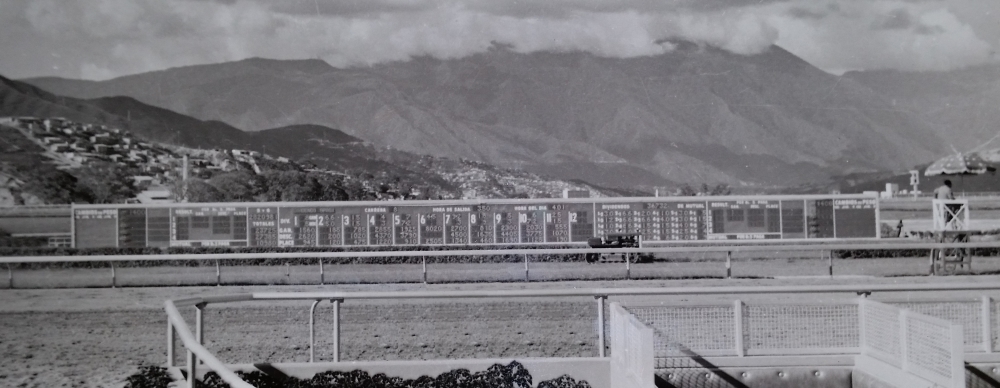
 Go back to the index
Go back to the index
 Go to the bottom of the page
Go to the bottom of the page
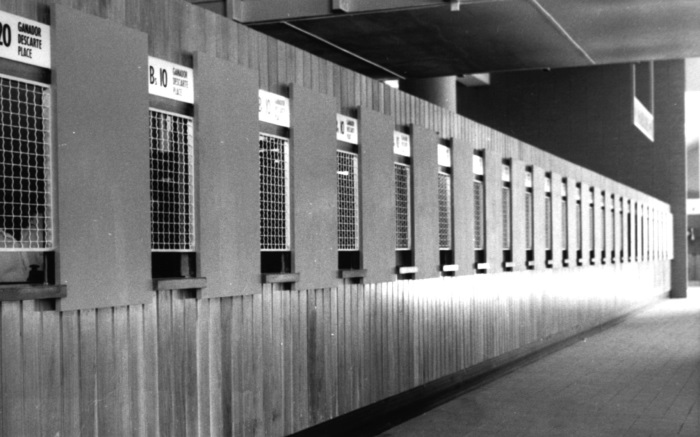
The above image is one of the Caracas tote houses containing some of the machines mentioned below
The Caracas installation has 123 ticket issuing machines selling, as required and nominated, bets for either Ganador (Win), Descarte (a second Win pool without the favourite) or Place (or for all three Ganador Descarte Place) on tickets of 5, 10, 20, and 50 bolivares. (Ganador Descarte and Place, can be seen on the sign above the first window grille in the image above, although it is a bit blurry. Ganador and Descarte can be seen in the indicator image above titled One of the Caracas Indicators )
The machine also sells Mutual (forecast) system tickets for 2, 5, 10, and 20 bolivares investments through 115 additional ticket-issuing machines.
Part of the machine mentioned in the last sentence, is shown in the following two images.
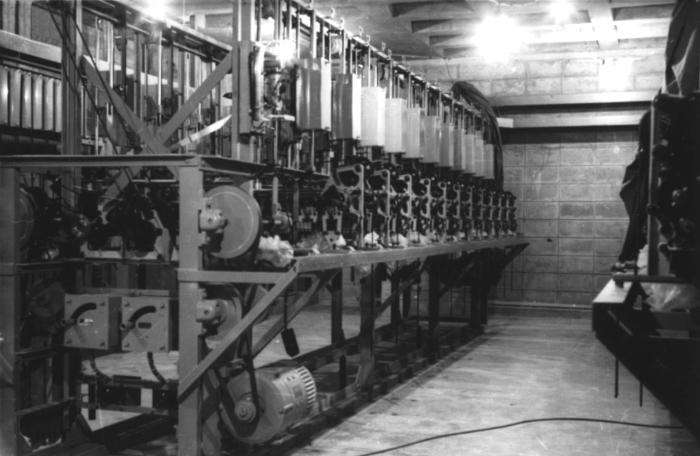 Part of the Caracas tote machine room
Part of the Caracas tote machine room
Webmaster's Notes:
The above image is part of the Julius Tote mainframe equipment at Caracas showing some of the pool runner adders and the odds calculation devices. Being one of the last Julius totes, it is state of the art and differs from earlier Julius totes in two major ways. These differences are described below under the heading Blue Bonnets Montreal the last Julius Tote Installation. Neville Mitchell made the following comment regarding the eleven white vertical rectangular boxes all in a row along and near the top of the rack of equipment in the middle of this image:
The boxes atop the Caracas adder frame are the drivers for the lamp box indicator. A slider system actuated by a draw cable to the Odds device on the Odds Slider bar.
Note that there is a twelfth device like the eleven others being discussed, the closest one, which looks different as it has its cover removed.The image below is another view of the Caracas mainframe equipment showing the Scanners, the circular devices, in the racks near the right hand wall. There are more adders on the table. The scanners can be thought of as the front end equipment of the Julius tote. Neville Mitchell, added the following about this image:
The relay boxes under the distributors are the OVER LAP relays that were always included in the usual Distributor Cubicle.The Overlap relays Neville mentions, held the transaction circuit voltage for the duration of the transaction cycle resulting from the enabling pulse from the Scanners. The Scanners were synonymously known as Distributors as Neville refers to them above.
Another part of the Caracas tote machine room
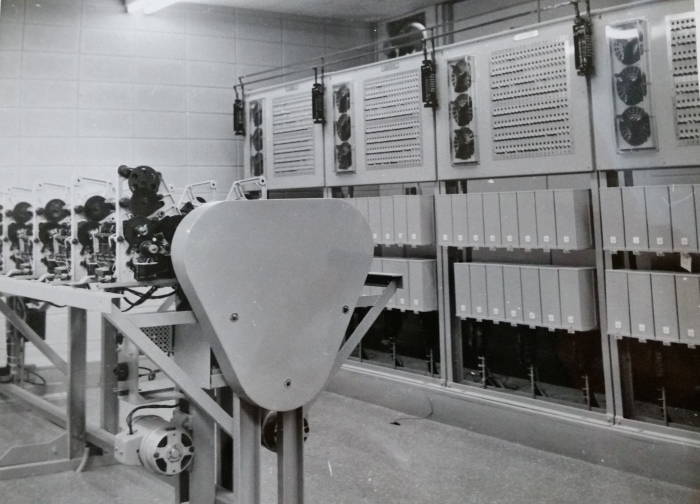
An exclusive feature of all Automatic Totalisator Limited installations is the selling of win, place and show tickets from the one ticket-issuing window as against separate windows necessary with other types of equipment.
Thus the total of 238 ticket-issuing machines at the Caracas Hippodromo Nacional is the equivalent of 484 ticket issuers on race tracks equipped with other than the Julius Premier Automatic Totalisator - and this fact, together with the speed and efficiency of the Julius Premier explains why it is the standard equipment at leading racecourses the world over.
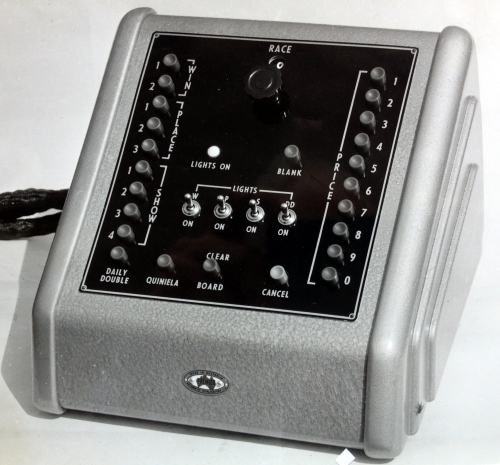 A Caracas Indicator Controller
A Caracas Indicator Controller
Webmaster's Comment:
The above indicator controller's photograph is labelled "INDICATOR CONTROLLER CARRACUS." The control button and switch text however is in English. I suppose this does not exclude it from being used in Caracas however considering the misspelling of Caracas makes you wonder about the veracity of the label!
A Caracas Results Indicator Controller 1960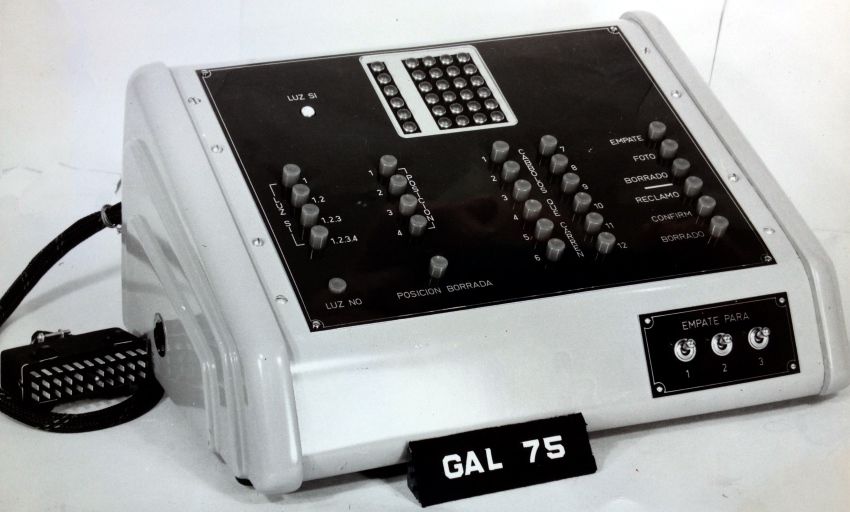
Webmaster's Comment:
In January 2016 Neville Mitchell wrote the following regarding the Caracas indicator control consoles like the ones in the two images above:The general principle of manual indicator control consoles operated as follows
- press select button for the display window i.e. Win
- press cancel button to delete current display
- enter data on input buttons
- release select button
- press lights on to display entry(ies)
- to delete all displays press Clear Board button
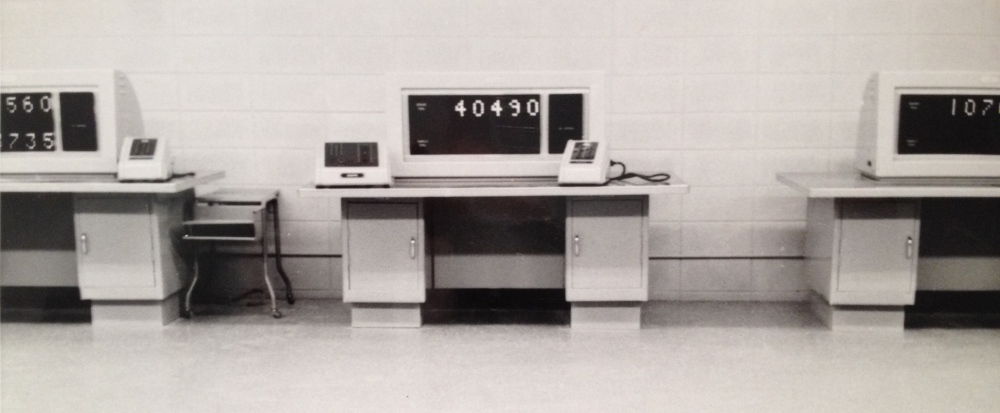
A specialty of the Julius Premier totalisator made by Automatic Totalisator Limited is the automatic ticket counter, as distinct from the bets counters. Located in the control room, ticket counters provide up-to-the-minute information on number of tickets sold and their values for each horse, as well as details on the comparative position of high and low value sales.
This is the end of the article titled Fabulous Caracas. The paragraph above introduces the automatic ticket counters. The next image below titled Caracas control room Ticket Counter console shows one of the automatic ticket counters.
| William Johnson's recollections of Caracas |
|---|
William Johnson now 74 (in 2013), worked for Automatic Totalisators Limited in Melbourne, Canada, USA, Venezuela and Malaysia, almost ten years overseas on totalisator installations and operations. Later as Service Manager of the Marketing Division he visited Sweden, Switzerland, and several times the USA, for instruction on the products introduced by this division. His recollections regarding Caracas and associated subjects follow:
I see Ladislav Jaros went on from Venezuela to the position in Europe. He was a very kind boss while in Venezuela for three years. He and his wife Elizabeth often included me in their journeys into different parts of Venezuela. I was a nineteen year old apprentice at the time.Following is a prior recollection of William's regarding the Caracas Automatic Totalisators installation:The installation team in Caracas comprised, Ladislav Jaros, Tallis Bachmanis from the drawing office to complete drawings, Archie Javes and myself. A Mr. ver Hoof from Holland was with us for a while. I remember meeting Mr. ver Hoof in Sydney when my father took him fishing on the central coast. We had a mixed nationalities work force of sixteen men from Cuba, Spain, Italy, Venezuela etc. Australian visitors included our Managing Director, Alf Boa, Head of Sales Don Hardy and Joe Norris.
I remember when the dictator Perez Himinez came in for a visit with his machine gun guards. We had to go past machine gun nests on our way to work during coup attempts.As I have introduced William here, I have taken the liberty of presenting some more of his recollections. In the following segment he recalls premises of Automatic Totalisators Limited prior to the construction of the factory at Meadowbank.When watching the Grand Prix race (Stirling Moss etc) a booby trap car blew up near the President. I had been to a work mate's daughter's christening. The bombed car is in the film.
Greetings from Bill Johnson, ATL apprentice from 1954.During the 2015 ATL reunion dinner, Bill Johnson gave me some old negatives relating to Caracas. Following are three images made from prints of those negatives. The first shows one of the display consoles in the Caracas control room:I can remember being on the roof of ATL during the war with my father. He took me to the roof to see the view and the siren. It was known as Chalmers Street from my memory? An earlier factory was the blacksmiths shop etc. maybe in Newtown.
Going down the street towards the railway you could see a large advert for hand lotion on the side of the building. Oil of Ulan in a very distinctive bottle???
I worked on the tracks in Melbourne with the introduction of the first doubles issuers etc. in 1955? Keith Dodwell was in charge.
Then to Canada for a few months, then Wilmington and later to Venezuela for three years on ATL's largest job. Tallis Bachmanis and Archie Javes were also in Venezuela. Tallis there from the drawing office to complete drawings! Ladislav Jaros from Brazil was in charge.
Returning I was seconded to Malaysia for six years etc.
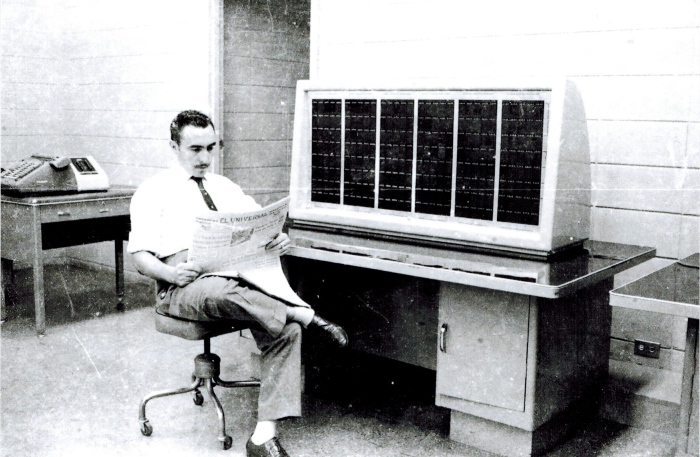 Caracas control room Ticket Counter console
Caracas control room Ticket Counter console
Following is information from Bill regarding the console in the image above:
5x8x6=240 Sodeko counters. From memory I thought they might be Doubles or Quinella counters. On looking again and seeing no control boxes on the table I am sure they are ticket counters. I remember the great clunk when the counters were all reset at the same time.Webmaster's Comment:
We had adders Ganador (Win), Descarte (take out the favourite and run as a win pool, and Place (plar say) that is place or show. Doubles or Quinella I cannot remember.
The counter displays are small and at this resolution look like horizontal dots on display. Within each of the six panels in this display, are eight rows of these apparent dots and each of these rows have five groups of these dots within a panel. This is the 5x8x6 matrix that Bill refers to and each of these five groups in each row in each panel are the digits that convey the ticket sales on a particular runner combination.
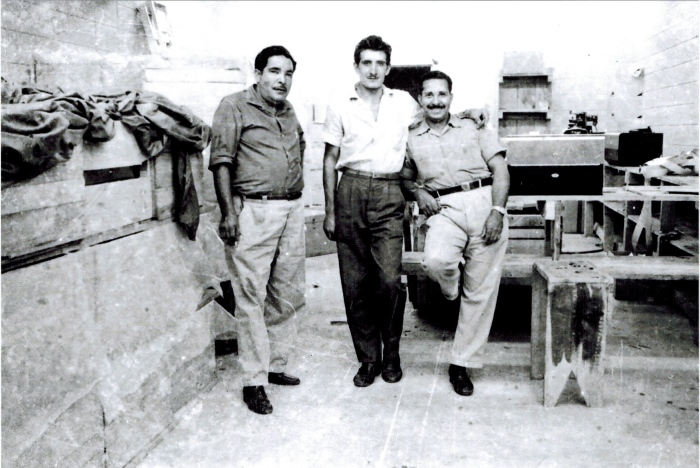
I wrote to Bill indicating that this image looks like the people are unpacking the crates containing the new J8 ticket issuing machines. There are two J8s on top of the bench on the right hand side and there seem to be unpacked crates of J8s on the left hand side. I also asked if Bill remembered any of the faces. He wrote:
I think you are correct with the unpacking of the J8's. I think the middle fellow was Emilio. He was our runner to do forms and visas and other necessary fixing of our cedulas (work permits). The other fellows I cannot remember names. In other pix I can remember some.
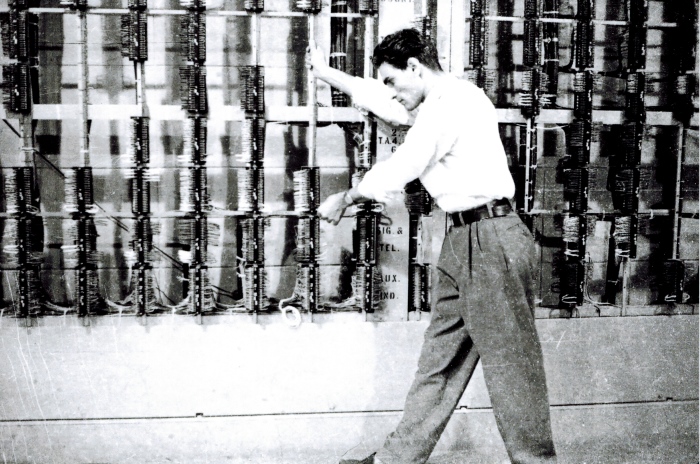 The Caracas Tote Main Distribution Frame
The Caracas Tote Main Distribution Frame
On 14/1/2016 Neville Mitchell wrote the following about the above image which shows the connections of the racecourse wiring to the central processing system and control room.
The terminal blocks are the type used after the demise of the oil filled potheads. They were made by Telephone Electrical Industries / Plessey in Meadowbank and Transmission Products in North Sydney they were standard PMG (PostMaster General's department), as used in 600, 3000 & Crossbar type exchanges.They were available in various formats the terminals arranged >> 2 X 4 rows by 20 high, 2 X 4 rows by 25 high, the maximum block was 8 X 25. ATL sometimes ordered blocks with double spacing, so the PVC betting cables could be terminated easily.
The terminals were brass, pre-tinned for easy soldering, The design was unique, a cable terminator could wrap a pre stripped wire around the terminal and without wire cutters, snap the wires tail off on the sharp end of the terminal. Often in Exchanges the terminal was not soldered as the wire wrap was sufficient to remain a good gas tight conductor. ATL always soldered the terminals as many blocks would see service in the tropics.
I had PMG technicians working on the Sandown Park Totalisator installation who would pit themselves against each other racing to terminate 100 pair cables.
The terminal blocks had a universal terminal numbering system. Starting from the top row of terminal nearest to the base the terminal was 101 (row one number 1) the last terminal in the row is 125, Row 2 starts with 201 through to 225 and so on according to the number of rows. Some terminal blocks had markers each 5 terminals to make locating a terminal easier.
You possibly remember the Julius designed Open Frame Terminal Blocks? They were used to terminate the 16 pin plugs to the J8- J10 issuers. Just a simple steel frame with rows of terminals Sufficient for 24 win and 24 place conductors and across the bottom row, race number 1-10, race change, Issuer motor power, open sales bell, telephone etc.. They were also used in Intermediate Distribution frames to join track cabling or cable T junctions. A simple design, as each conductor was in full view and it was easy to visually identify each wire and its function. They did not attract vermin, as the open frame made nesting difficult. The TEI blocks, being so dense, allowed termites to set up home, cockroaches would make a real mess. Termites could cause short circuits with their debris.
Sandown Park MDF (Main Distribution Frame)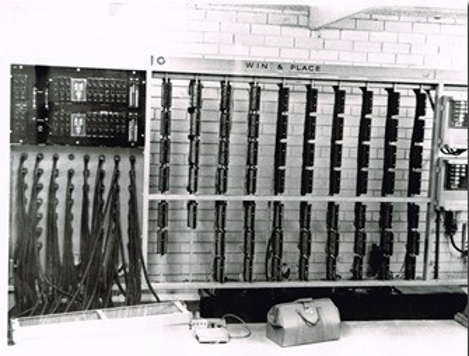
Neville sent the above image as he mentioned Sandown Park above. His accompanying text was: Sandown Park main IDF with TEI terminal blocks (this photo was taken on my last day at Sandown February 1966 my travel bag is ready for home.)
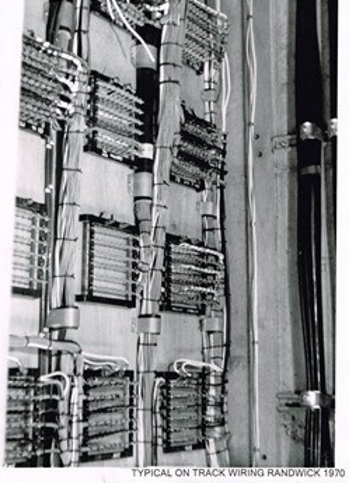 ATL Open Frame TB (Terminal Block)
ATL Open Frame TB (Terminal Block)
Neville sent the above image as an example of the Open Frame Terminal Blocks he mentions above. As can be seen in the caption in this image, under the photograph, this wiring is at Randwick in 1970. Neville wrote: A typical ATL open frame terminal block Installation in the vertical services duct adjacent to a selling line to the left.
In October 2006 William sent me the following information on an Automatic Totalisators product called Visitel:
On the New Inventors tonight, ABC Sydney etc, a short snippet was shown of the Both (as in moth) brothers. I remembered the names and recorded the session.Webmaster's Comments:One of their inventions was the Visitel made by ATL used to transmit by cable the dividends to the payout houses. A pencil was placed in a hole in a lever and you moved the pencil as normal to write the calculated dividends. A button on the left hand side advanced the paper.
The show tonight said it was so secret during the war it could not be released and was never used, but I remember seeing it used on racetracks.
I also saw my father tonight in the segment with other ATL staff looking at a demonstration, I have to look closer on the tape I recorded to see exactly what it was. My father was an apprentice with ATL from early days.
Both may have also designed the Wheatstone bridge setup for controlling the blind indicators displaying the odds & dividends.
I worked in Australia, Canada, USA, Venezuela and Malaysia on totalisators etc from 1954 for 27 years or so.
I recall seeing these devices on racetracks long after they had been made redundant. It struck me that they must have appeared quite futuristic in their time. I recall retaining one to ensure it was not discarded so I could take it with me as a memento when I retired. Unfortunately when I retired it had disappeared. - Never mind, I have a photograph :---
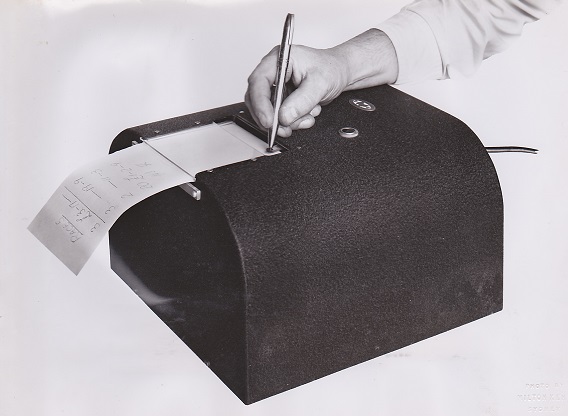
The Visitel receiver looks similar and prints a copy of what is written at the transmitter. It is being used here to send what looks like win and place dividends on runners 3 2 and 20 for race 5.
Some more remnant impressions from William Johnson follow, regarding the Caracas project from an earlier email. Alf Boa mentioned below, was the General Manager of ATL at the time. There is an image of the Infield Board, that William mentions below, further up this page titled The Caracas Infield Indicator, World's Largest Infield Indicator 1957:
Waiting 12 months with very little to do as the stands were not ready. Alf Boa said we had to be on site as per ATL contract. Dividend calculation bars arrived rusty and new ones were replaced. They were ground tubes and rusted easily without good protection and care. The Spaniard D. Paiser standing next to his lathe reworked the rockers as we could not set a reliable current setting on them. We sleeved them with Brass from memory. All the lamps for the infield board were clear and we hand frosted them in a chemical mix.
William has recollections of the Las Vegas installation in the Automatic Totlisators in America chapter of this website.
| Blue Bonnets Montreal the Last Julius Tote installation |
|---|
No this is not Caracas, however we are on the subject of latter-day Julius totalisators and I have just come across this image of the last of the Julius tote installations. As can be seen this system is the same architecture as the one at Caracas. It seems appropriate to display it here. Neville Mitchell has written a note which is attached to the photograph. It reads:
Multi Channel Adder Frame and Controls: Made for trotting track in Ottawa, Blue Bonnets raceway, 1964 - very last main adder type system ever built. - Note access relay sets replaced "distributor" T.I.M. control. Also note on frame direct readout to lamp box of odds via slider driver off Horse Adder/GT Adder. I worked long hours 7 days a week on this project.
Neville's comment of the long hours reminds me of a term Charlie Barton, Ex Chief Engineer of the Brisbane Julius totes, used to use with reference to tote engineer's wives. He used to call them tote widows!
Postscript -
There was some confusion over the location of this installation. Neville's note indicates that it is in Ottawa. After receiving an email from Chris Robertson in March 2005 correcting this error, I spoke to Neville about it. He said he was exhausted after this project and recorded the location in error. I have included an extract from Chris' email - But any respecting Francophone Canadian will take umbrage at the suggestion that Blue Bonnets Raceway is, or ever was in Ottawa. It won't come as any great surprise to you to learn I've actually been to Blue Bonnets and I can assure you it is in Montreal Quebec.)
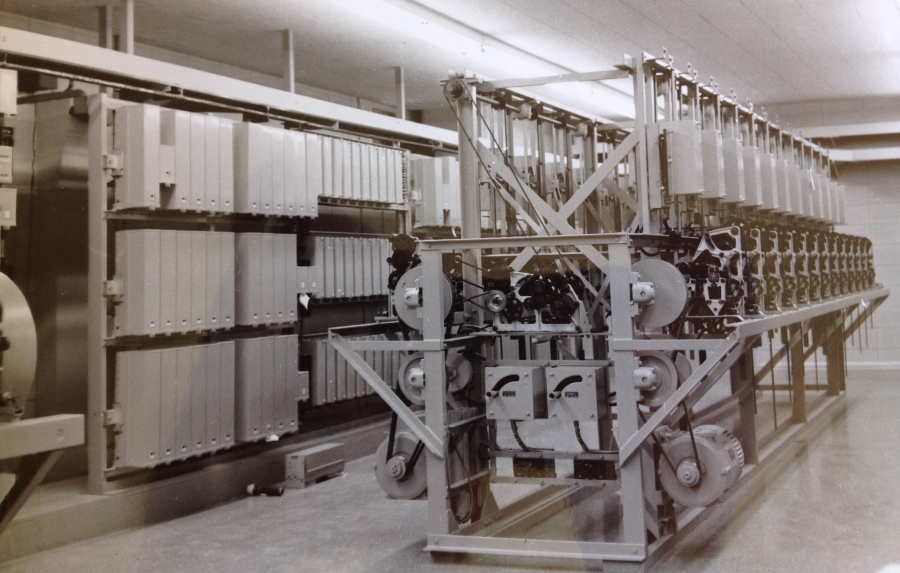 The Blue Bonnets Julius Tote
The Blue Bonnets Julius Tote
There are two elements of these most modern of Julius totes, like Blue Bonnets, that differ with their predecessors. First are the white boxes on the left hand wall in the photo. These replace the scanners or distributors in the older systems. Second are the odds calculating devices. The twelve boxes, one above each adder in the frame, in the right hand half of the image, replaces the previous generation odds calculating devices with their horizontal and vertical sliders and hypotenuse arms which were associated with each adder. Neville Mitchell has provided the following explanation in 2013:
The white boxes are Access relay units. These units replaced the rotary distributor systems. They were built in standard PMG relay boxes with quick detaching connector mounting system. The other boxes on the adder frame were the device used to drive the indicators. It was a sliding system, cable connected to the adder's "Odds" output. Its now 51 years since this machine was built in Meadowbank, I worked in late November through to December to get the equipment on a freighter leaving Sydney for Canada in January 1963.In April 2015 Neville wrote a bit more about the Access Relay sets or units on the left hand wall:
The introduction of 3000 type relays into what was named "Access relay sets" spelt the end of the Julius win place totalisator Rotary Distributor and its associated "Overlap" relays. The access relay set accepted the bid for a bet from a W/P ticket machine, excluded any other machines while the bet was processed. The first coil was used to accept the bid while the second low resistance coil maintained the relay operated until the Trip Current is disconnected by the ticket machines trip contacts and the bet was recorded on various totalisator adding machines, i.e. Mini Adders, Counter totes. The Mini format dual coil relays also had a system where a permanent magnet held the relay operated with one coil and was released by the second coil e.g. J11 Confirm relay.In September 2015 Neville wrote some more:
I would say that the relay ACCESS sets were not created prior to 1960ish. I think they were developed by Peter Rolls, Terry McCauley and George Klemmer. The "Blue Bonnets" adder frame was under work in the period up to December 1962. I worked with Colin Holz, & George Klemmer. It was set up in the then Godown loading dock that had recently been floored over the loading ramp. The Relay boxes atop this adder would have been similar/same as Caracas. They were to drive the standard Auto Tote lamp box, using 2 of 5 data code for 4 x 6 matrix lamp boxes.In November 2021, Bob Plemel, a long serving ex Engineering Manager of Automatic Totalisator Limited, who happens to be Canadian, wrote the following about this Montreal System:Lots of adders were manufactured and tested on basic test gear known as "love boxes". Some were automated to run a adder for an hour to check for escapement wheel hang ups. later a manual cranked box was used for final testing. Access relay sets were not factory tested as quality assurance was so strict and there was no test rig for them.
I remember discussions with Peter Rolls about the Montreal tote. He had good stories about the french workers. I remember one quote he gave about the french electrician that came to do the power wiring 2 wires make a light, 3 wires make trouble.Canada still uses 2 wire 100V AC and only use 3 wire 220 V for high power applications.
As we have touched on Canada, here are some more Canadian installations. These are all electromechanical Julius Totes.
| Club De'Course Lviolette Inc - Trois Rivieres | Flamboro Downs - Ontario | Provincial Raceway Inc. (Richelieu Park) - Montreal |
| Le Piste De Courses De Quebec, Inc. - Quebec | Sherbrooke Racing Club - Sherbrooke | Saquenay Race Track - Jonquiere |
| A Sad Time for the Ex-Autotote/ATL Fraternity |
|---|
Three days after a wonderful Automatic Totalisators Limited annual reunion dinner in 2015, we received sad news indeed of one of our fraternity.
Bill Johnson passed the following information on by email for distribution to Nick D'Angelo, who organises the ATL reunion dinners: Thanks for the great organization of our recent dinner. I was looking for information on Keith for ages as Neville had lost touch.
The email contained a link to a Legacy website obituary for Keith Dodwell who is a legendary character within our fraternity.
Bill also wrote: Can you arrange to pass this on to those who knew Keith from your great list. They can sign the condolence book on the site.
Following is a copy of the Obituary courtesy of Mari Dodwell who wrote it:
Keith Dodwell AGE: 87 Hockessin
Passed away peacefully on Tuesday, December 1, 2015 at Compassionate Care Hospice after an extended illness.Born in Sydney, Australia, Keith was the son of Radnor and Myra Dodwell. He began his career as an apprentice tool maker with Automatic Totalisators in Sydney and moved to New York City to open a branch of the company in 1952. Several years later, he moved the company's U.S. headquarters to Wilmington, Delaware. He retired as Executive Vice President in 2002 after several location moves and a change of the company name to Autotote.
Keith travelled extensively during his 59 years with the company but was always happiest to return home to his beloved boat Southern Cross on which he enjoyed many years sailing and fishing on the Chesapeake Bay. He also loved working with tools and was a master at repairing just about anything. Keith had many friends and touched each with his kind nature, sense of humor and selflessness. He enjoyed spending time with his extended family and was often the "life of the party".
In addition to his parents, he was predeceased by his brother, John Dodwell. Keith will be dearly missed by his wife of 43 years, Mari Elizabeth (Hobbs) Dodwell; his brother, Noel Dodwell (Eunice); his sister, June Noble; his nephews Kenneth Noble (Nolene), Grant Dodwell (Sian) and Gregory Dodwell; his nieces Jennifer Adams (Steve), Caroline and Judith, all of Sydney, Australia; and his brothers-in-law Richard Hobbs (Sandy) of Aston, Pennsylvania and Alan Hobbs (Thea) of Lewes, Delaware; his sister-in-law Michelle Dougherty Hobbs (Michael) and his nieces Nicole Hobbs and Brittany Hobbs of Wilmington, Delaware.
Like Neville, I too had lost contact with Keith and was concerned about him. As recorded at the top of this page, Keith had achieved an amazing record of working for the same organisation for 60 years. Our calculation for Keith's length of service with the company differs a year from Mari's 59 years, a difference which I think will have a trivial answer and consequently is not worth pursuing. As Mari and fellow workmates record, Keith started working for Automatic Totalisators Limited as an apprentice. Bill Johnson thinks Keith is in a photograph on this website, in the Photo Gallery continued chapter, as a youthful apprentice. I have included a reduced version of the image here. Bill thinks Keith is in the centre of the first standing row behind the other youth in the photograph who is seated.
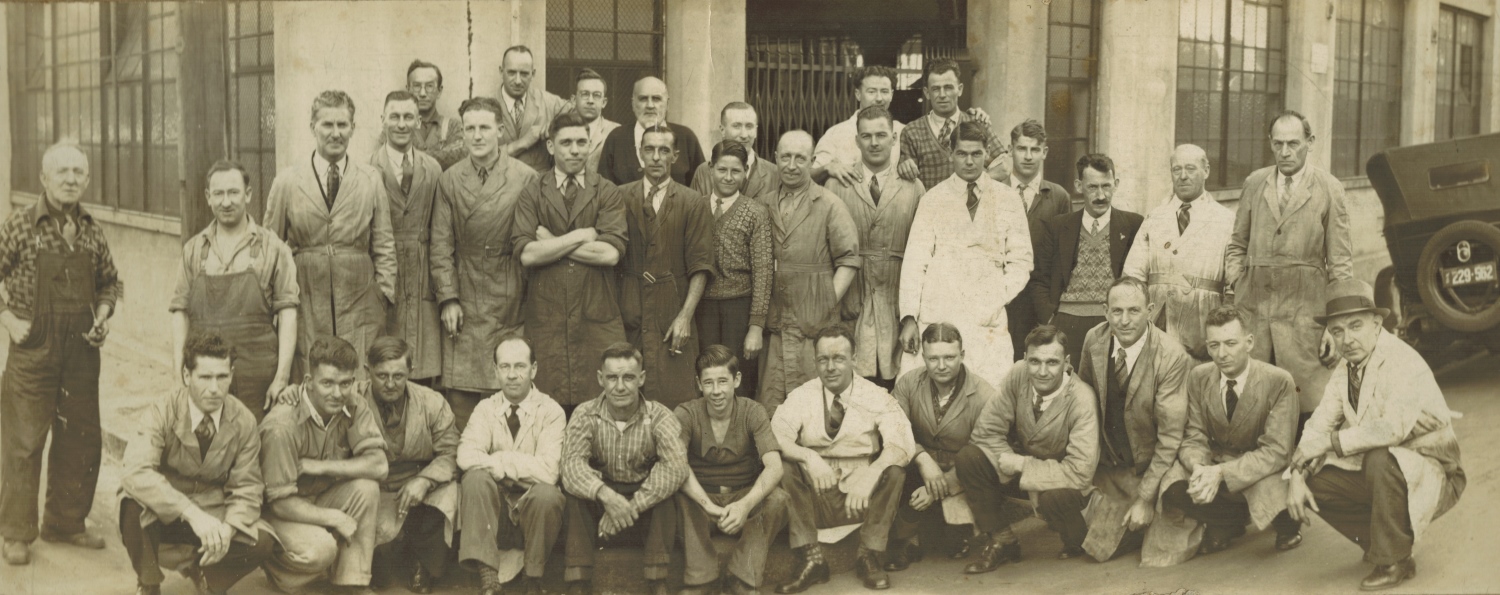
As Mari wrote in Keith's obituary, he moved to New York in 1952 to establish a subsidiary company of Automatic Totalisators Limited in the United States. This subsidiary company was originally named ATUSA (Automatic Totalisators USA) before it was renamed Autotote. I was very fortunate to meet Keith when I visited Autotote in Philadelphia from Automatic Totalisators Limited in Sydney in 1983.
Mari's obituary for Keith relates Keith travelled extensively during his 59 years with the company but was always happiest to return home to his beloved boat Southern Cross on which he enjoyed many years sailing and fishing on the Chesapeake Bay. In my conversations with Keith, I realised he had not forgotten his Australian roots. This is evident in the name of his boat "Southern Cross" after the Crux Constellation, which is outstanding in the night sky in Australia.
Neville Mitchell also recalls a good time had in the USA, with Bill Johnson, Keith and Mari Dodwell as well as their boat: I was talking to Bill about our time together at ATUSA, we had some great times with Keith and Mari Dodwell. Sailing on their yacht on Chesapeake Bay, dining at Du Pont restaurants, and in between doing some work.
Keith's sister June, married another iconic Automtic Totalisators Limited Manager that I also have many fond memories of, Norm Noble. Neville thinks that June is in a photograph of the Automatic Totalisators Limited Head Office Typing Pool in the Memories of the factory chapter of this website.
Following are some memories of Keith from ex ATL staff who recorded them in Keith's Legacy Obituary Guest Book:
December 11, 2015
I worked under Keith on several installations and operations in Melbourne, Canada, USA and Venezuela. Always a gentleman, great teacher and great workmate. Many happy memories spent in his company. Rest in peace Keith.
William Johnson
December 11, 2015
Our deepest sympathy. I knew Keith through 32 years of working for Automatic Totalisators Limited in Meadowbank Sydney. We met in Newark and sailed on the bay, a few days I have never forgotten. I was a good friend of Keith's brother in law Norman Noble and Keith's sister June. We would dearly love to find June again as we have lost touch, maybe Ken could contact me on nevnan1@hotmail.com.
I believe Keith dedicated 61 years to the Totalizator world a magnificent effort.
Neville & Nancy Mitchell
December 13, 2015
I am saddened by the news of Keith's passing. I remember him from his trips to Australia to visit Automatic Totalisators where I worked. I have fond memories of my trips to visit Autotote in Willington where Keith would go out of his way to make our trip enjoyable.
Bob Plemel
December 13, 2015
It is a very sad day that we have lost such a great guy like Keith. He was always ready to help and was fun person to be with. He made many friends and will be sadly missed by all. I have many good memories from my association with Keith over the years.
John Pickering
And my entry:
December 14, 2015
Narelle and I have wonderful memories of Keith who was very hospitable to us when I visited Autotote in Philadelphia from Automatic Totalisators Limited in Australia in 1983. We have exchanged several interesting emails since. He has contributed to the Totalisator History website at http://members.ozemail.com.au/~bconlon/caracas.htm
Farewell Old Friend
Brian Conlon
On 5 January 2016 Peter Collier, ex Automatic Totalisators Limited Chief Engineer in Victoria wrote an email regarding Keith. Following is an extract. It was sad to hear about Keith. I have a memory of a wonderful lunch when Keith took Clive Angus and I to his yacht club. This was during a side trip we took to visit Autotote in 1981 on our way to Boston for our VAX780 training course.
Autotote was actually located at 100 Bellevue Road, Newark, Delaware. Very close to the border with Philadelphia.
My memory of Keith, is in the preceding paragraph to Peter's above and my experience was much like Peter's except I was attending a VAX-11/750 course and my visit was after the course. On Reading Peter's comment, I thought he must be psychic as he answered a question I had about the location of Autotote, which I had not asked of him. I wondered why everyone else thought Autotote at the time was located in Delaware and I visited them in Philadelphia. Peter states their premises were in Delaware on the boarder with Philadelphia.
Joe Brandon, ex-Autotote Engineer and Manager, wrote when he heard the news Extremely saddened to hear of Keith's death. He was a good friend and someone I really admired. I will get the word out as best as possible. Joe passed on the following photo of Keith from Stan Rec.
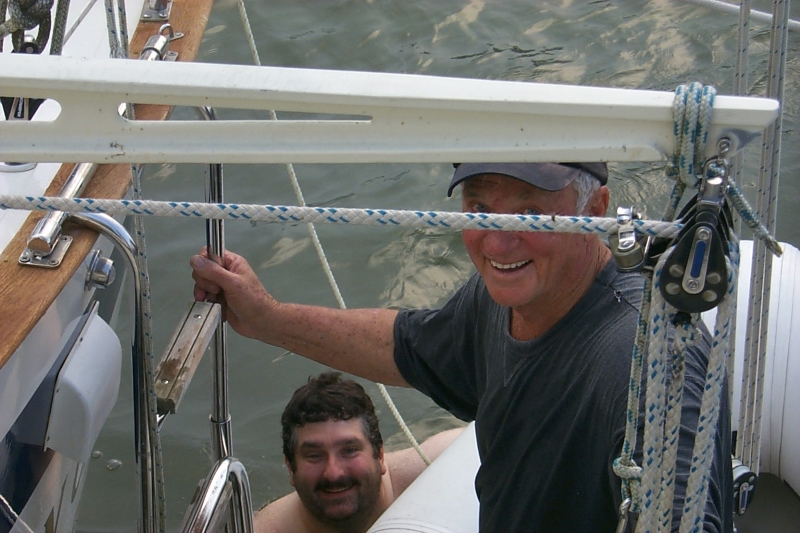
Although this image is not the most flattering of Keith, due to the rigging rope across his face, I think it has an attribute, which more than compensates for this. It is an image of Keith doing what he obviously was so passionate about. Furthermore Keith is in the company of a friend Stan Rec and fellow employee of his company Autotote. Stan was a computer programmer with Autototote, which was later renamed Scientific Games. He presently works for the Las Vegas Dissemination Company, the leader in Pari-Mutuel wagering and race track simulcasting.
| Acknowledgements |
Comments and suggestions welcome to
totehis@hotmail.com 
| Previous page | Go to the index | Top of the page | Next page |